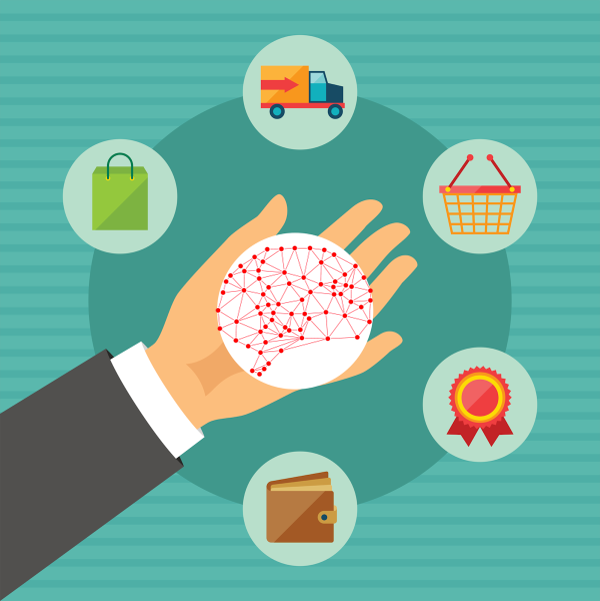American serial entrepreneur Nolan Bushnell (@NolanBushnell), founder of Atari, the Chuck E. Cheese’s Pizza Time Theater chain and numerous other businesses, notes, “Today, companies have to radically revolutionize themselves every few years just to stay relevant. That’s because technology and the Internet have transformed the business landscape forever. The fast-paced digital age has accelerated the need for companies to become agile.”[1] Nowhere is Bushnell’s assertion more true than in the marketing industry. Futurist Kurt Cagle (@kurt_cagle), founder of Semantical, asserts, “Marketing is constantly evolving in response to the business environment. Today marketing and advertising are vastly different than they were three decades ago.”[2] One of the technologies dramatically impacting marketing is artificial intelligence (AI). Carol Haney (@carolsuehaney), head research and data scientist at Qualtrics, explains, “The rise of artificial intelligence has dramatically changed the way businesses and brands understand and communicate with their target audiences.”[3] Bill Hanifin (@billhanifin), CEO of Hanifin Loyalty LLC, adds, “It seems like everyone is trying to identify how artificial intelligence can benefit their business. In my circles, executives are asking how AI will impact customer marketing, more specifically data-driven customer marketing.”[4]
Leveraging data for marketing
It’s no coincidence that artificial intelligence came out of a long period of stagnation with the maturation of the Internet and smartphone technology. AI requires large amounts of data to work properly and today most companies are flush with data. Haney suggests five ways AI and Big Data can be used to know and serve consumers better. They are:
1. Understanding What Customers Really Want. Haney notes, “AI gives market researchers access to tools like powerful automated text analysis, which can analyze millions of comments, both voice and text, in minutes and emerge with a nuanced understanding of what customers think and want.”
2. Finding Respondents Faster, With Higher Accuracy, in a Way That Maximizes Existing Data. “Using AI,” Haney writes, “market researchers can review a wider pool of respondents and remove those who aren’t suitable, resulting in better, more tailored shortlists of potential candidates.”
3. Removing Bias from Customer Feedback. Bias can be a big problem and get companies in serious trouble. Haney explains, “Bias is a huge risk: It has the potential to skew to the integrity of data. However, AI is able to remove subconscious human bias both from respondents and from study design.” AI doesn’t remove bias automatically; data scientists need to tweak algorithms to ensure bias does not exist.
4. Conducting Extensive Secondary Research. One of the great benefits of cognitive systems is their ability to provide insights that might not be readily apparent. According to Haney, “Using AI means companies can analyze secondary research quickly and identify key trends and themes in the data — without needing the help of management consultants to do the heavy lifting of analysis for them.”
5. Continuously Improving the Quality of Studies. Haney asserts, “The quality assurance aspects of AI cannot be overstated. AI can pinpoint areas where questions need improving or where there is bias. Machine-learning can also be used to optimize the collection of future customer feedback based on previous data.”
Hanifin agrees both brands and consumers benefit when data is properly leveraged in marketing. He explains, “Data-driven customer marketing (you might know it as loyalty marketing) is designed to change customer behavior in a positive way for both the brand and the customer. The short-term goal is to hit financial objectives like increased sales, visits, etc., while the long-term goal is to establish valuable, long-lasting, mutually beneficial relationships that insulate the brand from competitive offers.”
The power of advanced analytics
According to Hanifin, “Enhancing your analytics engine with AI can make it possible to optimize individual experiences at scale. Next-generation analytics, fueled by AI, can make hypersegmentation possible (i.e., homing in on more precise groups of customers who share specific attributes and behaviors). As a next step, you can optimize dynamic content for delivery across channels in a timely manner, with the result being a delightful customer experience and higher satisfaction levels.” Today, advanced analytics are embedded in cognitive platforms, like the Enterra Enterprise Cognitive System™ (AILA®) — a system that Sense, Think, Act, and Learn®. One of the strong suits of cognitive computing platforms is their ability to perform predictive analytics. Taj Nota, Vice President of Professional Services UK at NGDATA, explains, “Predictive Data Analytics is the process of using historical and current data combined with machine learning to forecast certain outcomes. In the marketing world, predictive analytics uses monitoring and reporting to accurately plan strategies and campaigns.”[5] Nota suggests six ways predictive analytics can benefit brands.
1. Finding better leads. Nota writes, “Using the historical data of both a certain company and the industry a company is in, certain factors pertaining to sales leads can be found using Predictive Analytics.” He notes insights gained through analysis can be used for, ad targeting, content generation, lead prospecting, targeted sales conversations, and identifying prospects faster.
2. Identifying prospects faster. “Many companies,” Nota explains, “employ the use of a customer relationship management software (CRM). These tools typically include a way to score leads. Scoring is simply a numbering system to alert the marketing and sales team when a lead is close to making a decision. When this data is combined with machine learning and artificial intelligence, identifying sales-qualified leads becomes easier over time.”
3. Aligning sales and marketing. According to Nota, “Marketing team and sales team have very different roles. More often than not, this results in a breakdown in communication that can cost a company revenue.” He insists analytic insights can be used to bring the teams closer together by allowing them to hand off leads, communicate information about of promotions, implement and update CRM systems; quantify the quality of leads in the funnel, and better understand current customers.”
4. Understanding current customers. As Haney noted above, AI can help enrich a company’s understanding of its consumer base. Nota adds, “Predictive analytics helps to understand not only leads and new customers, but also the behaviors of existing clients.” For example, the Enterra Shopper Marketing and Consumer Insights Intelligence System™ can leverage all types of consumer data to provide high-dimensional consumer, retailer, and marketing insights.
5. Marketing automation. Nota writes, “Perhaps one of the most impactful ways predictive analytics will reshape the marketing world will be through automation. Once the behaviors of lucrative prospects are identified, sophisticated programs can interact with leads almost immediately.”
6. Better budget allocation. John Wanamaker, the late department store magnate, once stated, “Half the money I spend on advertising is wasted. The trouble is I don’t know which half.” Nota explains AI can help the budgeting process. He writes, “Improved understanding of who your buyers are, where you can find them and the resources to use to garner interest can all dramatically decrease ad spend waste.”
Nota concludes, “Predictive data analytics is quickly becoming the driving force behind modern marketing. From drastically improving lead qualification to better aligning sales and marketing initiatives and making targeted marketing automation more in-tune with customers’ needs in-the-moment, predictive data analytics amplifies the ability to cater to individual customers — and that’s the magic formula for success in the modern marketing landscape.”
Concluding thoughts
Hanifin concludes, “Customers are becoming more aware of the value of their data every day, and what it represents to the brands they patronize. Delivering a highly personalized experience communicates clearly to the customer that their favorite brand ‘gets it,’ meaning they might just wonder how the brand managed to connect with them in a natural, organic way that encouraged them to visit, purchase, recommend it, etc.” Haney adds, “As artificial intelligence evolves and its use becomes more mainstream, the potential benefits for experience management researchers — and businesses as a whole — will only increase.”
Footnotes
[1] Nolan Bushnell, “Fast-Paced Quotes,” Brainy Quotes.
[2] Kurt Cagle, “How To Market In The Twenty-First Century,” Forbes, 26 July 2019.
[3] Carol Haney, “Five Ways AI Is Changing the Future of Marketing Research for the Better,” MarketingProfs, 25 September 2019.
[4] Bill Hanifin, “What Artificial Intelligence Means For Customer Loyalty Marketing,” Forbes, 3 October 2019.
[5] Taj Nota, “Six ways predictive data analytics are reshaping marketing,” ITProPortal, 16 April 2019.





